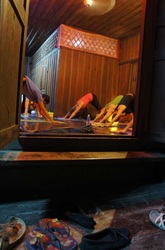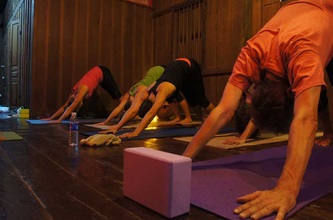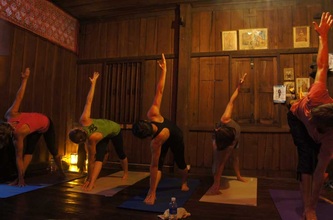 There are good yoga teachers, and then there are great yoga teachers. The good teachers challenge us. Physically, they help us push the limits of our capabilities. Mentally and emotionally, they impart confidence, self-worth and discipline. The great teachers however, touch our souls in a way that causes a vital shift to our inner being, leaving us a little bit transformed. In this lifetime, we will likely only encounter a handful of these great teachers. We may not recognize them upon first meeting them. Most probably, we would not have heard of them before. Teachers like these do not seek fame. Rather, they practice and teach, touching one person at a time, without the need for recognition and without the need to be commended. In the end, it is not their goal either to instill these changes in others. Those who come with an open heart and mind will gain the benefit of their teachings. Those that are closed to it will not. They don’t tell us what we should or should not do or think. They do not judge us for how we live our lives. Most importantly, great teachers grow in us, the desire to be better people, to be selfless people. In a single class, these teachers can make you feel your smallness in the larger scheme of the universe, yet feel so connected to it at the same time; to want to sacrifice your own goals for those of humanity; to feel deeply for all of humanity; to have compassion for all things good and bad; to love and to truly seek peace. To all the inspirational teachers out there, THANK YOU! Blog post by Julie (juliehana.com)
1 Comment
 Let’s face it people, yoga injuries do happen! And, they’re on the rise. In 2007, the U.S. Consumer Product Safety Commission (CPSC) reported 5,500 yoga-related injuries that were treated in emergency rooms or doctors’ offices. In 2010, that number increased to 7,369. Whether the growth of reported injuries is a result of more people taking up yoga or because we’re finally admitting to it, the fact is, they are happening. Moreover, these figures are probably also understated as there’s still reluctance amongst many in the yoga community to concede to the notion that yoga can do harm. Now wait a minute! I’m a yoga teacher, so why am I telling you this? I should be telling you about all the positive things that come with developing a regular yoga practice right? Well, I’m about to do that too. But the important lesson here is that, just like other physically challenging activities, you can hurt yourself. Accepting this is the first step in injury prevention. Yoga used to be viewed by many as a practice that could do no harm, so people practiced as if this were true. We now know this view to be incorrect. Approaching your yoga practice with awareness of your body and awareness how the practice relates to your own body is essential. So now, the good stuff. I’m off course a strong proponent of yoga. I’ve practiced for 10 years now and seen my body transform over the years. I’ve managed chronic knee and back pain through yoga and even kept my lymphangioma, a malformation of the lymphatic system, under control. Yoga has been known to relieve medical conditions from arthritis, to auto-immune diseases such as multiple sclerosis. From a mental and emotional perspective, it helps us to sweat the small stuff less. But all this would be for nothing if we don’t learn to keep our yoga practice safe.  I know it sounds cliché, but ultimately, the ego is the number one cause of yoga injuries. It’s not just the ego of the student that can be harmful, but that of the teacher as well. To quote an article by Sura in the Huffington Post (The Dark Side of Yoga): “The way people approach life is the way people show up on their yoga mat. And yoga teachers are no exception. Some yoga teachers may lead with a sense of aggression and competition while others will promote a feeling of safety and peace.” While yoga is a practice that’s supposed to help us let go of our ego, the reality is that we are ego-full beings. It’s not uncommon for the ego to be unleashed before it is diminished. For students, this may mean forcing ourselves into a posture that our bodies may not be ready for. For teachers, it may mean telling students to come to class despite their injuries, just to keep attendance high. Both are incredibly dangerous. It’s also not uncommon in class to hear the teacher say things like “breathe through the pain” and “work around your edge.” I’m not a fan of the “one size fits all” approach and find that phrases such as these can be incredibly harmful. For someone that’s more sluggish, lacks energy and harder to motivate, encouragement to work around his or her edge can be safe enough. However, for the competitive, high-energy, driven person, these words may be the extra half centimeter in hanumanasana (forward split) that leads to a torn hamstring, the straight legs that leads to an injured lower back, or the extra 3 breaths in sirsasana (headstand) that causes the neck and shoulder injury. Furthermore, teachers need to feel ok to tell their students to stop their yoga practice until they consult a physician, especially when the teacher is not well informed about the student’s condition. And certainly there’s nothing wrong with saying, “I don’t know, but let me consult a senior teacher or yoga therapist and get back to you. In the meantime, avoid this posture/practice until I find out more.” Yoga can be an incredibly beneficial practice to all, but it’s up to each individual, whether student or teacher to ensure the practice remains safe and sustainable. Blog post by Julie (juliehana.com)  Jessica Magnin began her workshop last weekend by asking, “How many people made a new year’s resolution this year?” Out of a room full of 20 people, only four raised their hands. Then came the question, “For those who did not make one, why didn’t you?” The answer, for most, was simple. New year’s resolutions almost always fail. And there you have it, the word “FAIL” or “FAILURE.” Jessica explained that more often than not, the resolutions that we make are coupled with the potential to fail. Furthermore, resolutions such as “I will quit smoking this year” or “I will go to the gym four times a week” are created as a result of what we think we “should” be doing. A dictionary defines “should” as “used to indicate obligation, duty or correctness, typically when criticizing someone’s actions.” Thus in creating many of our resolutions, we’re engaging in a cycle of self-criticism, which leads to failure when the resolution is not fulfilled, which again leads to even more self-criticism.  What if we were to change the way we made our resolutions? According to Jessica, choosing the right words and the right intention is key. So let’s start at the top and instead of “creating a resolution” let’s call it “seeding our intentions.” Right there, we generate an image of new beginnings, of growth and of continuous change. We switch from what our brains think we “should” do to what our hearts feel we “want” to do. In choosing the words of your intention or Sankalpa, keep to larger and more general concepts such as happiness, peace or health rather than specific material desires such as money, career or body weight. Write down a few words or phrases, and then perhaps even a sentence using these words and phrases. When writing the sentence, be sure to begin the sentence with “I have” or “I am” rather than “I want” or “I must” so it becomes something positive that you are already experiencing.  It’s a simple process really, but the result is empowering. Repeat your Sankalpa to yourself three times and let it resonate from the depths of your heart. Feel it taking place already. Take this further by combining a yoga practice focused on back-bending to open the heart and the throat where anahata chakra and vishuddhi chakra are respectively located, manifesting thoughts and speech into reality. With the creation of the proper intention, seeded from the right words and right purpose, feel the connection to your true self or the nature of goodness within yourself that is unaffected by outside factors. Add twisting postures to your practice to illuminate your spine and remember, “the light within you is the same light that illuminates the entire universe.” Thank you Jessica for your teachings and thanks to all the participants who showed up to support the SMILE Project. Blog post by Julie (juliehana.com) In December 2012 Al Jazeera producer and Huffington Post journalist, Bhanu Bhatnagar, completed his yoga teacher training and taught his first yoga class at the practice space in Ban Aphai. In line with the yoga community’s commitment to Karma Yoga, or service, the class was held as a fundraiser for the Traditional Arts and Ethnology Center (TAEC). Proceeds of the class that was held on December 10 went towards supporting TAEC’s mission of preserving cultural diversity in Laos.
Bhanu recently wrote about his first teaching experience in the Huffington Post. The article is a reflection on an experience that most yoga teachers can appreciate. For students, this is a great insight into some of the challenges that your teachers face as they strive to deliver guidance, knowledge and compassion in their classes. Read the Huffington Post article. The following photographs were taken by Casey Conroy.  A close friend and recent guest teacher wrote an article in the Huffington Post’s Lifestyle section about the importance of a strong yoga community. This is a topic that resonates with me and one that I find close to my heart, as I often contemplate the growth of a yoga community here in Luang Prabang. Upon first setting foot on the peninsula in August 2011, I thought that surely such a spiritually inspiring and picturesque location would be host to a yoga community resembling those that I’ve encountered in Bali, Thailand and India. Alas, besides a small number of expatriates that gathered together several times a week to practice, there just wasn’t the same buzz about yoga in Luang Prabang as in other places. I’m talking about the kind of community that draws both teachers and students together from all over the world just to share the joy of yoga. I’ve met many people here in Luang Prabang that practice on their own. I agree strongly with the Huffington Post article’s comment that while cultivating a personal practice is incredibly important, being part of a yoga community can help your practice transcend and take you places you never thought you’d end up. Within a strong yoga community, the open exchange of ideas, thoughts, personal struggles and challenges can leave you more open and accepting, not to mention the encouragement you receive from people who care. A safe community where teachers can learn from teachers, teachers can learn from students, and students can learn from each other encourages us to be nonjudgmental and helps us to let go of our ego and fear. The Luang Prabang yoga community is gaining momentum, and it is important to mention that as communities get larger, so does the challenge to keep it unified. I believe the key to creating and preserving a close-knit community lies in our ability to uphold the principals of the practice of yoga and apply it not only on the mat, but also off the mat. As my friend reminded us in the Huffington Post, yoga means “union” of the body, mind and soul. This union furthermore applies to our relationships with each other and ultimately our relationship to the universe in which we live. I’d love to hear your thoughts on the subject. Click the following link to read the Huffington Post article: A Stong Yoga Community Makes all the Difference to Your Practice, by Bhanu Bhatnagar Blog post by Julie (juliehana.com) |
Archives
September 2023
Categories
All
|










 RSS Feed
RSS Feed
